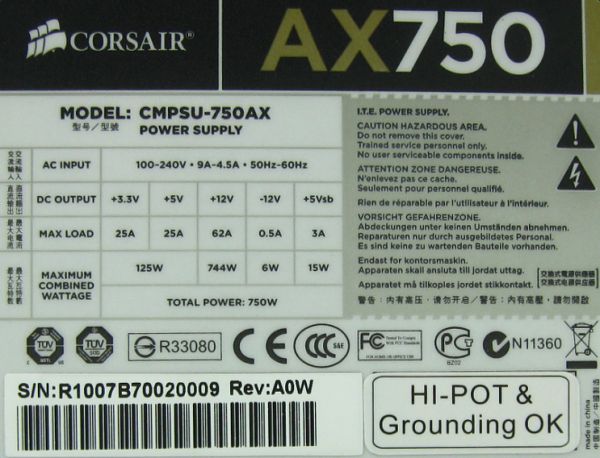Corsair AX750 80 Plus Gold: Putting Corsair's Best to the Test
by Martin Kaffei on November 30, 2010 12:00 AM EST- Posted in
- Cases/Cooling/PSUs
- Corsair
- PSUs
- 80Plus Gold
- 750W
Package Contents and Power Rating
There are a few extras in the package, which is typical of high-end PSUs. Included are several cable ties, mounting screws, the power cable, and a users manual, plus a couple of cloth bags that can be reused. On the package we can see that the AX750 is EuP-ready (low power loss in standby mode) and is a compact design measuring 160mm including the modular connection panel. Their reviewer's guide suggested we look at efficiency at 50% load, where the AX750 will be at the maximum 90% or greater level, but we'll also look at how it handles lower and higher loads.
Here we have an external impression of the Corsair model. The Case has a black, scratch-resistant surface with a Corsair logo on both sides. It has honeycombed ventilation holes and a small power switch near the AC plug. It's a very well-made product, with our only complaint being that the fan grille protrudes a little.
Corsair uses a single +12V rail that nearly delivers the full rated power. The AX has DC-to-DC for the smaller rails, so +12V feeds +3.3V/+5V and you can't use the whole 62A there. Even so, Corsair wants to supply modern components with plenty of juice, and 744W minus (up to) 125W is still a good rating. As you can see on the label, 100-240VAC and 50-60Hz are no problem for this PSU. The Corsair AX has active PFC, and we've tested the efficiency and PFC on both power grids.













34 Comments
View All Comments
Chapbass - Tuesday, November 30, 2010 - link
On the cables and connectors page: last para:The only potential issue is if you want to load up all we SATA connectors with a bottom-mounted PUS; the distance from the PSU to the first connector is only 45cm (give or take), with a fairly large 12-13cm gap between the connectors, so you'd want the HDD bays to be relatively close to the PSU rather than in the top portion of the case.
First sentence has a few typos. Still reading, but figured I'd point it out.
Shadowmaster625 - Tuesday, November 30, 2010 - link
Aren't all PUS's bottom mounted?Stuka87 - Tuesday, November 30, 2010 - link
Many newer cases do use a bottom mounted CPU, but it is hardly the only form factor.Stuka87 - Tuesday, November 30, 2010 - link
CPU should be PSU. Wish there was an edit :/Iketh - Wednesday, December 1, 2010 - link
pretty sure they're rear-mounted when bent overNintendesert - Tuesday, November 30, 2010 - link
Last page, first paragraph."Gold requirements. 91% at 50% load is not to shabby."
It should be "too shabby."
Chapbass - Tuesday, November 30, 2010 - link
Gotta say this PSU looks impressive. I'm going to need something soon for my server (not much in the way of cpu and video power, but along the lines of 18-20 HDD's), and something like this might fit the bill. we'll have to see :)props to corsair, another solid unit.
prince34 - Tuesday, November 30, 2010 - link
I've been looking for a new high quality PSU for a new build early next year. This looks very promising. Also, Newegg has a $20 mail in rebate and $15 promotional code with free shipping. Thats $135 up front and $115 in the end. That is hard to beat.mino - Tuesday, November 30, 2010 - link
This left me puzzled though:"The AX has DC-to-DC for the smaller rails, so +12V feeds +3.3V/+5V and you can't use the whole 62A there."
I know of exactly ZERO XXX-watt power supplies where you can load 3.3V or 5V _in_addition_to_ the XXX watts being consumed on 12V rails.
Actually, most PSU's on the market do not allow anywhere near 99% of its rated load purely via 12V rails like this one. So if anything, such an arrangement should considered a plus.
Beenthere - Tuesday, November 30, 2010 - link
These days there are lots of PSUs to chose from and the devil seems to be in the details. History has shown that Seasonic can produce good PSUs under their own brand and for other companies but that not all PSUs from them are not equal in design or performance.Without knowing exactly what the hardware differences are between PSUs and how this impacts performance or reliability makes it challenging when purchasing a new PSU. I watch hardware sites for patterns of issues with specific PSU models and brands when I'm looking for a new PSU.